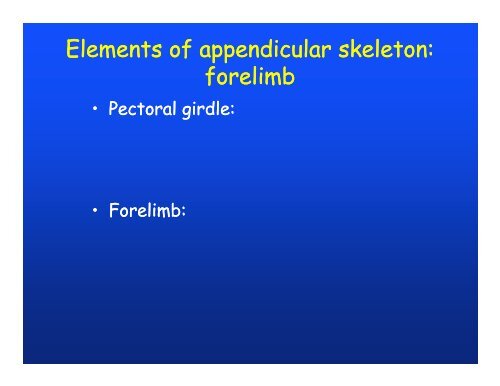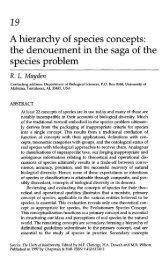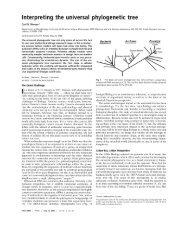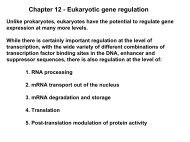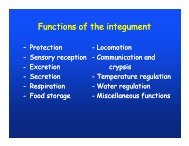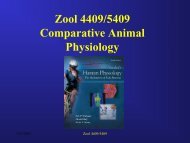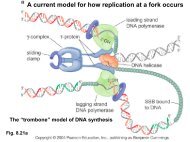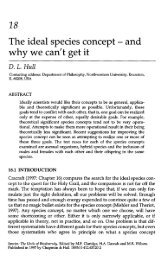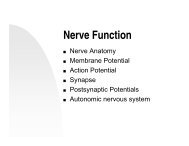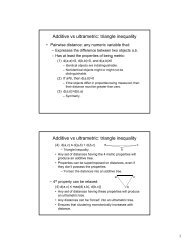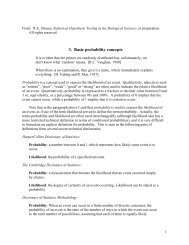Elements of appendicular skeleton: f li b Elements of appendicular ...
Elements of appendicular skeleton: f li b Elements of appendicular ...
Elements of appendicular skeleton: f li b Elements of appendicular ...
Create successful ePaper yourself
Turn your PDF publications into a flip-book with our unique Google optimized e-Paper software.
<strong>Elements</strong> <strong>of</strong> <strong>appendicular</strong> <strong>skeleton</strong>:<br />
• Pectoral girdle:<br />
fore<strong>li</strong>mb<br />
• Fore<strong>li</strong>mb:
Mammals<br />
Anterior<br />
Posterior
Limbs and associated muscles are<br />
derived from somatic hypomere:
Hox gene expression in:<br />
Bony fishes<br />
Tetrapods
Pectoral girdle<br />
Modifications <strong>of</strong><br />
the basic fish<br />
pattern in<br />
vertebrates<br />
Anterior<br />
Dermal<br />
elements<br />
Endochondral<br />
elements
Shark
Medial view<br />
Lateral view
Tiktaa<strong>li</strong>k<br />
rosae<br />
• Sarcopterygian.<br />
• Shallow-water fish, but with:<br />
– Robust pectoral <strong>li</strong>mbs, functional wrist<br />
– Well-supported ribs<br />
– Functional neck
Pentadactyl fore<strong>li</strong>mb structure:<br />
Hallux
Number <strong>of</strong> digits in<br />
early amphibians<br />
initially varied<br />
from 4-13<br />
Digits reduced in<br />
<strong>li</strong>ving amphibians<br />
Theropods
Convergent evolution<br />
<strong>of</strong> external forms<br />
using different<br />
combinations <strong>of</strong><br />
skeletal elements
Historical constraints on adaptation<br />
• Ex: Giant panda’s thumb:<br />
– Pandas related to bears and raccoons<br />
(Carnivora).<br />
– Bears /raccoons are the most omnivorous<br />
carnivores.<br />
• Use front paws to manipulate food.<br />
– Giant panda are more dexterous than bears<br />
and raccoons.<br />
• Diet restricted to bamboo.<br />
• Strip leaves between flexible “thumb” and<br />
other digits.<br />
– Problems:<br />
• Primates have opposable thumbs, not<br />
carnivores.<br />
• 5 (not 4) remaining digits.
Constraints on adaptation<br />
• Panda’s thumb:<br />
– Enlarged carpal bone:<br />
• Bears: s<strong>li</strong>ghtly enlarged radial<br />
sesamoid bone.<br />
• Carnivores: two 1 st -digit abductor<br />
muscles.<br />
• In bears, one muscle attaches<br />
instead to radial sesamoid.<br />
• Abductor and adductor muscles are<br />
modified 1 st -digit abductors.<br />
– Panda’s thumb is modification <strong>of</strong><br />
carpal structures.
Limb<br />
configurations<br />
Amphibian and<br />
repti<strong>li</strong>an<br />
condition<br />
(2 effective<br />
<strong>li</strong>mb segments)<br />
Mamma<strong>li</strong>an and<br />
archosaur<br />
condition<br />
(3 effective<br />
<strong>li</strong>mb segments)
“Muscular s<strong>li</strong>ng”<br />
<strong>of</strong> mammals
<strong>Elements</strong> <strong>of</strong> <strong>appendicular</strong> <strong>skeleton</strong>:<br />
hind<strong>li</strong>mb<br />
• Pelvic girdle<br />
• Hind<strong>li</strong>mb
Mammals<br />
Anterior<br />
Posterior
Anterior<br />
Posterior
• Acanthostega :<br />
– One <strong>of</strong> first amphibians with well-defined digits (8)<br />
on fore<strong>li</strong>mbs, hind<strong>li</strong>mbs.<br />
– Limbs extended laterally, not ventrally.<br />
– Joints (elbow, wrist, knee, ankle) present but with<br />
<strong>li</strong>ttle mobi<strong>li</strong>ty.
Sue’s foot<br />
(Tyrannosaurus rex)<br />
Theropod<br />
feet (4 toes)<br />
Utahraptor<br />
Vulture<br />
Hallux
Human pelvis
Human pelvis
Knee<br />
Wrist<br />
Elbow<br />
Ankle
Models <strong>of</strong> <strong>li</strong>mb evolution<br />
• Account for two major transitions<br />
in chordate <strong>li</strong>mbs:<br />
– Aquatic fin folds to fins.<br />
• “Fin-fold theory”.<br />
– Fins to tetrapod <strong>li</strong>mbs.<br />
• “Axial” and “basal” models.
Cephalochordate<br />
condition<br />
Fin-fold<br />
theory<br />
Fish condition
Fin-fold model
Models <strong>of</strong> <strong>li</strong>mb evolution
Hagfishess<br />
Chondrichthyes<br />
Selachii<br />
Lampreys<br />
Sharks, rays<br />
Chimaeras<br />
Sarcopterygii<br />
Crossopterygii<br />
Dipnoi<br />
Lungfishes<br />
Coelacanths<br />
Tetrapods<br />
Bichirs<br />
Sturgeons, paddlefishes<br />
Gars<br />
Bowfin<br />
Bonytongues, knifefishess<br />
Tarpons, eels<br />
Herrings,<br />
anchovies<br />
Minnows,<br />
, characins, catf<br />
fishes<br />
Salmons,<br />
trouts<br />
Dragonfishes<br />
Lizardfishes<br />
Lanternfi<br />
ishes<br />
Spiny-rayed fishes<br />
Silversides, kil<strong>li</strong>fishes<br />
Cods, anglerfishes<br />
Vertebrata<br />
Gnathostomata<br />
Osteichthyes<br />
Teleostei
Basal model<br />
Axial model
Axial model<br />
• Lungfish condition is plesiomorphic.<br />
• Axial bones homologous with<br />
posterior long bones + carpals +<br />
metacarpals + phalanges.<br />
• Evidence: embryonic and gene<br />
expression patterns <strong>of</strong> vertebrate<br />
<strong>li</strong>mb development.
inductive sequence
Basal model<br />
• Coelacanth (crossopterygian)<br />
condition is plesiomorphic.<br />
• Long bones are homologous with basal<br />
fin elements (heterochronic change).<br />
• Radials are homologous with carpals +<br />
metacarpals + phalanges.<br />
• Supported by phylogenetic evidence<br />
for monophyly y <strong>of</strong> the sarcopterygians.
Context <strong>of</strong> evolution <strong>of</strong> tetrapod <strong>li</strong>mb<br />
• Late Silurian – Devonian (410-400 mybp):<br />
– Diversification <strong>of</strong> plants into semi-aquatic and terrestrial<br />
habitats.<br />
– Formation <strong>of</strong> wetlands and rivers with abundant plant<br />
<strong>li</strong>fe.<br />
– Appearance <strong>of</strong> terrestrial insects.<br />
• Transition from fin to <strong>li</strong>mb preceded that from aquatic<br />
to terrestrial habitats.<br />
– Early <strong>li</strong>mbs sufficient for shallow, muddy waters.<br />
– Multiple, clearly defined digits.<br />
– Weak girdles and <strong>li</strong>mbs, weak wrists.<br />
• Tetrapods: reduction <strong>of</strong> dermal bone, elaboration <strong>of</strong><br />
endochondral elements.
Structure <strong>of</strong> the vertebrate <strong>skeleton</strong><br />
• Two major sections:<br />
– Axial <strong>skeleton</strong><br />
– Appendicular <strong>skeleton</strong><br />
• Heterotopic elements<br />
• Articulations
Some heterotopic elements<br />
Penis bacula
Structure <strong>of</strong> the vertebrate <strong>skeleton</strong><br />
• Two major sections:<br />
– Axial <strong>skeleton</strong><br />
– Appendicular <strong>skeleton</strong><br />
• Heterotopic elements<br />
• Articulations (arthroses):
Synarthroses
Amphiarthroses
(forming<br />
meniscus<br />
layers)<br />
Diarthroses
Femoral ball-<br />
and-socket<br />
joint
Trends in the skeletal system<br />
• Interna<strong>li</strong>zation: from external dermal <strong>skeleton</strong> to<br />
internal endochondral <strong>skeleton</strong>.<br />
• Differentiation <strong>of</strong> regions <strong>of</strong> the skull and axial<br />
<strong>skeleton</strong>.<br />
• Cepha<strong>li</strong>zation: i independence d <strong>of</strong> head from<br />
postcranial <strong>skeleton</strong>.<br />
• Development and specia<strong>li</strong>zation <strong>of</strong> pentadactyl<br />
<strong>li</strong>mbs.<br />
• Relocation <strong>of</strong> <strong>li</strong>mbs from lateral to ventral.<br />
• Interlocking <strong>of</strong> vertebrae via zygapophyses.<br />
• Reduction (loss and fusion) <strong>of</strong> skeletal elements.


